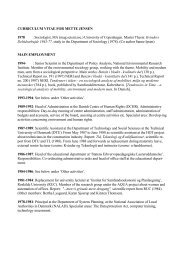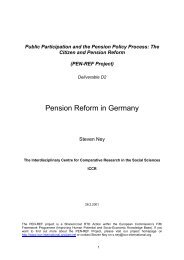The Housing Dimension of Welfare Reform - the ICCR
The Housing Dimension of Welfare Reform - the ICCR
The Housing Dimension of Welfare Reform - the ICCR
Create successful ePaper yourself
Turn your PDF publications into a flip-book with our unique Google optimized e-Paper software.
close to a 0 percent reduction rate <strong>of</strong> affordability risks while Belgium,<br />
Ireland and Germany are to be found around <strong>the</strong> 50 per cent line.<br />
Remarkable is Austria where <strong>the</strong> housing impact <strong>of</strong> social transfers<br />
exceeds <strong>the</strong> effect on poverty risks. Austria and Denmark are also those<br />
countries with <strong>the</strong> highest level <strong>of</strong> affordable housing.<br />
3.4 Social services and programmes targeting housing<br />
Several social services or programmes entail a housing element in<br />
recognition <strong>of</strong> <strong>the</strong> importance <strong>of</strong> housing for integration and social<br />
inclusion. <strong>The</strong> EUROHOME-IMPACT project evaluated some <strong>of</strong> <strong>the</strong>se<br />
programmes in different countries.<br />
<strong>The</strong>re were two kinds <strong>of</strong> case studies.<br />
• <strong>The</strong> first concerned programmes targeting persons facing <strong>the</strong> risk <strong>of</strong><br />
income poverty and/or unemployed and also confronted with a<br />
housing problem. Related programmes were investigated in Austria,<br />
Denmark and Switzerland.<br />
• <strong>The</strong> second concerned re-housing services targeting homeless<br />
persons. Related services were investigated in Germany, Italy and<br />
Ireland.<br />
In <strong>the</strong> two sections that follow – sections 3.4.1 and 3.4.2 – we outline <strong>the</strong><br />
methodology followed in <strong>the</strong>se case studies. <strong>The</strong> first set was<br />
conceptualised as programme evaluations. Those concerned with<br />
programmes targeting homeless persons tried, in particular, to assess <strong>the</strong><br />
long-term impact <strong>of</strong> re-housing on integration.<br />
3.4.1 Evaluation guidelines<br />
A programme evaluation must consider <strong>the</strong> appropriateness <strong>of</strong> <strong>the</strong><br />
resources in relation to its objectives, <strong>the</strong> environment and <strong>the</strong> internal<br />
dynamics <strong>of</strong> <strong>the</strong> programme as well as <strong>the</strong> short and medium-term effects<br />
including any unintended effects which may interfere with <strong>the</strong> desired<br />
effects.<br />
<strong>The</strong>re are two types <strong>of</strong> relevant questions with regard to programme<br />
evaluation: diagnostic questions and assessment questions.<br />
EUROHOME-IMPACT FINAL REPORT 45









